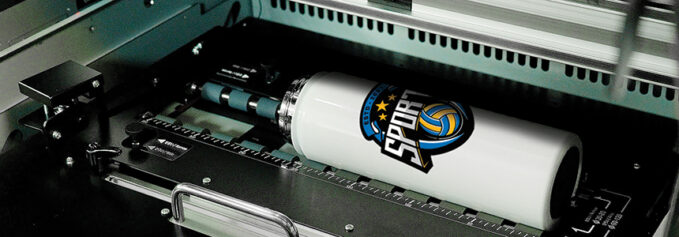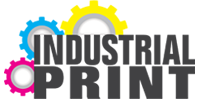
by Melissa Donovan
Printing direct to object (DTO) means many things, from flat drink coasters to more challenging coffee mugs. Luckily, technology that handles both ends of the spectrum and everything in between is accessible to both novice and experienced users.
Above: Mutoh’s XPJ-661UF is the company’s flagship desktop-size UV flatbed printer designed for versatility—including the ability to print on cylindrical objects.
For introductory purposes, a desktop-size UV digital printer is practical and cost effective. Especially for cylindrical objects. It’s easy enough to print a small, flat object and then either place a jig or rotary tool into the printer—if applicable—to print directly to a cylindrical item.
Common cylindrical-type objects that can be printed on a desktop UV flatbed printer, according to David Bistrovic, product manager, Professional Imaging, Epson America, Inc., include tumblers and water bottles, glassware, mugs, golf balls, pens, yo-yos, flashlights, and small containers.
“Desktop flatbeds are great cylindrical printers because they provide flexibility. Cylindrical is one function, but you also get the other benefits of a fully capable DTO printer for decorating small objects and even producing UV DTF stickers with compatible inks,” explains Lon Riley, founder/CEO, The DPI Laboratory.
Businesses short on space, but big on ideas, can easily take advantage. “Desktop-size UV flatbed printers are an excellent choice for printing cylindrical objects because they offer a compact footprint without sacrificing capability. The printer can be placed on a table or mounted on a stand, making it ideal for tight workspaces,” notes Emilio Rangel, UV product manager, Mutoh America, Inc.
The technology on today’s devices, more specifically the UV ink sets, make it all possible. “Desktop-sized UV flatbed printers are compact and versatile solutions for printing on cylindrical objects. UV ink adheres to most materials, cures instantly under UV light, is scratch resistant, and offers high durability, ideal for high-use cylindrical objects such as pens, golf balls, and glassware,” says Bistrovic.
Tools that Make it Possible
A desktop-size flatbed UV printer may be equipped with a rotary tool or have the capability to handle various jigs that hold cylindrical items. Both options have their own benefits as well as limitations.
According to Rangel, neither rotary units or jigs are inherently more difficult to use. They are designed for different applications—the choice depends on the object being printed.
A rotary tool rotates the object during printing, which allows for printing all the way around the cylindrical object, explains Bistrovic.
Full-wrap designs on cylindrical items such as bottles, tumblers, glasses, pens, and lip balm tubes are all easily printed using this method, says Rangel.
However, “rotary tools are limited to printing within the Y axis boundaries of the printhead width, so you will print fewer units simultaneously but get better coverage,” explains Riley.
Jigs are utilized to decorate curved or irregularly shaped items like golf balls, ornaments, or cosmetic cases. “A custom built jig holds items securely in place for accurate, high-quality prints,” notes Rangel.
“While it typically allows printing on only a portion of each object’s surface, a jig can hold multiple items, producing many things in a single print, which can decrease order turnaround time and increase productivity,” shares Bistrovic.
While a jig provides the benefit of allowing more units to be printed at one time, Riley cautions that the “coverage area will be limited to smaller logos and linear word marks.”
Production Levels
Desktop flatbed UV printers are capable of reaching production-level printing of cylindrical objects, but are also practical for one-off and/or prototyping scenarios for users.
When equipped with a rotary attachment, Rangel believes desktop-size UV flatbed printers are best suited for short-run or one-off cylindrical prints, “as the slower rotation and print speed limit high-volume output.”
Full production is an option, admits Riley, if multiple printers are used simultaneously. “Often multiple flatbed machines with rotary systems can match the production speed of a dedicated system, while providing redundancy for the same or less cost.”
If a jig is used, Rangel says these printers can easily support production-level workflows. “Their precision, reliability, and compact footprint make them a strong choice for specialty applications where volume is moderate, but quality and flexibility are essential.”
Bistrovic points out that production level also depends on the item. “For example, a printer may be able to print 50 pens in one pass using a jig, but only be able to accommodate two tumblers at a time using a similarly sized jig, making batch size a key factor in overall output.”
Quality Vs. Speed
Users—and even customers—of desktop-size UV flatbed printers consider quality as well as speed when it comes to printing to cylindrical objects.
There is a balance between speed and quality that most hope to achieve, says Rangel. “While some prioritize fast turnaround for short runs or personalized products, others focus on achieving the highest possible detail and with the best adhesion.”
“Most print shops aim to strike a balance, offering high-quality output at necessary productivity speeds that ensure customer satisfaction,” agrees Bistrovic.
Whether speed or quality is more important may be application dependent. “For small cylindrical objects, such as pens and golf balls, quality is critical; given the limited print area, it’s essential the output is sharp with fine lines and clear details,” explains Bistrovic.
“Quality is normally non-negotiable, but the greater the speed, the better the production and higher profit,” adds Riley.
Product Roundup
The DPI Laboratory offers two flatbed machines, which come with a rotary system as part of the core package. The Catalyst Nanos is an A3-sized printer with a rotary capable of accepting objects up to 3.5 inches in diameter. The larger Aventra system has a 900×600 millimeter print area and what makes it unique is the almost 36-inch width combined with a seven-inch clearance, which means it can rotate much longer and thicker objects.
The Epson SureColor V1070 desktop UV flatbed leverages six-color CMYK, plus white and varnish to produce prints on a variety of media and objects. The addition of white ink supports printing on colored substrates as well as clear and acrylic by printing a white base layer prior to the color ink to make prints stand out. The SureColor V1070 can use custom jig inserts for small cylindrical objects, including keychains, golf balls, pens, water bottles, and tumblers.
One of LogoJET Inc.’s latest products is the Inspira UVx45i with a 18×24-inch print area and a maximum substrate height of five inches. It is equipped with Inspira Series H2DX UV-curable ink. The newly engineered ink set offers enhanced adhesion and ink flexibility for broader product applications. Enhanced clear varnish spot printing is also available.
Mimaki USA, Inc. offers the UJF-3042 MkII e desktop-size UV LED flatbed printer. Available in a bed size of 11.8×16.5 inches and offering the ability to print on objects up to six inches thick, the included Rasterlink7 RIP software offers variable data and jig printing functionality. Applicable is the Kebab option, which enables 360 degree direct printing on a range of objects, such as stainless steel tumblers, bottles, cans, vases, packaging, and candle holders.
Mutoh’s XpertJet (XPJ) 661UF is the company’s flagship, desktop-size UV flatbed printer designed for versatility—including the ability to print on cylindrical objects. With a 19×23-inch bed size, it fits easily in compact spaces while still offering enough capacity for a range of applications. When paired with a rotary unit, the XPJ-661UF handles cylindrical items like bottles, tumblers, and glassware with precision and ease. What sets it apart is the combination of advanced printhead technology, strong ink adhesion, and user-friendly design. The Mutoh XPJ-661UF printer supports layered printing, including ADA-compliant braille, as well as texture and gloss effects, without complicating the workflow.
Cylindrical Flex
Desktop-sized UV flatbed printers offer the flexibility to print to all types of cylindrical items, from traditional bottles, tumblers, and glassware to curved, irregularly shaped products like golf balls, ornaments, cosmetic cases, and writing utensils. Depending on the printer, jigs or rotary attachments enable the decoration of cylindrical objects.
Sep2025, Industrial Print Magazine



